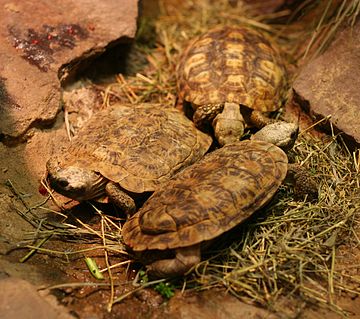Type the name of the breed you're looking for below
[wpdreams_ajaxsearchlite] Don't see the breed your're looking for? Click here and let us know!
Pancake Tortoise
| Place of Origin and Range | This East African species is native to southern Kenya and northern and eastern Tanzania, and an introduced population may also occur in Zimbabwe. The species has also been reported in Zambia. |
| Description | While the shell bones of most other tortoises are solid, the pancake tortoise has shell bones with many openings, making it lighter and more agile than other tortoises. The carapace (top shell) is brown, frequently with a variable pattern of radiating dark lines on each scute (shell plate), helping to camouflage the tortoise in its natural dry habitat. The plastron (bottom shell) is pale yellow with dark brown seams and light yellow rays, and the head, limbs and tail are yellow-brown. |
| Morph Patterns Available | Yes |
| Adult Size | Can grow up to 7in(18cm) |
| Accommodation | Arid Rocky or savannah habitat. To avoid injuries anchor any rocks in the vivarium before you add the substrate. In this case sand. You will want to include a large dish for bathing and soaking in to improve shedding. Always include a day basking spot at 80'F(27'C). Along with multiple hides. Minimum 2 x 8 feet for an adult. |
| Lifespan | Can live 10+ years |
| Feeding / Diet | Mixture of fruit and vegetation. |
| Other Considerations | Watch for theses health concerns carefully with your tortoise. Vitamin A Deficiency: Vitamin A is an important nutrient for your tortoise’s health. It is found in his diet in the form of leafy green, orange or yellow vegetables, liver, and fish. If your tortoise is not getting enough Vitamin A, he can suffer serious health problems. Always check to make sure that your tortoise does not have swollen eyelids, as this is the main sign of a Vitamin A deficiency. Also, check for weight loss, nasal discharge and infected skin. Any of these symptoms could point to a deficiency. If you think your tortoise may not be getting enough Vitamin A, you should take him to the veterinarian to get a firm diagnosis. Shell Problems: Your tortoise's shell is very important to his overall health. There are many potential problems that could occur, so you should be on the lookout at all times. Respiratory Disease: Respiratory infections have symptoms similar to vitamin A deficiency, including swollen eyelids and runny nose, so you should take your tortoise to the veterinarian to get a proper diagnosis if you suspect either. More serious infections will be characterized by breathing through the mouth, mucus in the mouth, and wheezing. Always make sure your tortoise’s environment has the proper amount of humidity, as this will help prevent respiratory problems. |



